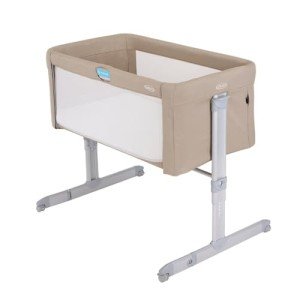The Versatility of Bedside Cots: A Comprehensive Guide
Bedside cots have actually gained popularity amongst new parents for their multifunctional design and ease of use. These versatile sleeping services permit caretakers to keep their newborns close while making sure safety and convenience. In this article, we will check out the functions, benefits, and various options readily available in the market for bedside cots, along with offer answers to often asked concerns.
What is a Bedside Cot?
A bedside cot, typically described as a co-sleeper or sidecar crib, is a small bed designed to be connected to the parent's bed. This design permits parents to have their baby within arm's reach while keeping a different sleeping space. Numerous bedside cots are adjustable in height, making it much easier to align them with the height of the parents' bed.
Secret Features of Bedside Cots:
- Attachable Design: Most bedside cots feature a safe attachment mechanism to the parent's bed, ensuring security for the baby.
- Adjustable Height: Many designs permit height adjustments to match the moms and dad's bed mattress.
- Breathable Mesh Walls: To enhance exposure and air flow, the majority of styles include mesh sides.
- Compact Size: Bedside cots are usually smaller than standard cribs, making them perfect for smaller spaces or easy mobility.
- Safety Features: Safety is paramount, and many bedside cots feature features such as locking systems and tough frames.
Advantages of Bedside Cots
Bedside cots not just promote safe co-sleeping practices however also bring a myriad of advantages that boost the parent-child bonding experience. Here are a few of the most considerable advantages:
1. Close Proximity
Having the baby close allows moms to react quickly to their infant's requirements, consequently promoting attachment and ensuring a soothing environment for the kid.
2. Easier Nighttime Feeding
Breastfeeding mothers discover bedside cots immensely handy as they get rid of the need to get out of bed for nighttime feedings. This can lead to a more relaxing night's sleep for both the parent and the infant.
3. Safety and Comfort
Bedside cots provide the security of a separate sleeping space while still producing the intimacy of co-sleeping. This plan is often recommended by pediatricians to lower the danger of SIDS (Sudden Infant Death Syndrome).
4. Space-Saving
For households living in smaller homes or houses, bedside cots are a space-efficient option compared to standard cribs.
5. Adaptability for Growing Babies
Lots of bedside cots can transition into a standalone crib and even a playpen as the baby grows, ensuring long-term use.
Kinds Of Bedside Cots
Before buying a bedside cot, it is necessary to understand the different types available. Below are the most typical varieties:
- Standard Bedside Cots: These attach straight to the parents' bed and can be quickly moved.
- Travel Bedside Cots: Portable models are lightweight and collapsible, making them perfect for travel or holiday.
- Convertible Cots: These can be transformed into a full-size crib or play location, offering prolonged use.
- Swivel Cots: Some models feature a turning design, allowing parents to quickly reach the baby without having to lift them.
Purchasing Considerations for Bedside Cots
When looking for a bedside cot, it is crucial to take particular factors into account:
- Safety Certifications: Always examine for safety requirements from trustworthy companies such as the Consumer Product Safety Commission (CPSC).
- Relieve of Assembly: Look for models that are easy to establish and protect to the bed.
- Product Quality: The products used in the cot must be non-toxic and sturdy enough to withstand daily use.
- Price Range: Depending on features and design, prices can differ considerably. Review your budget plan and select a cot that fulfills your requirements.
- User Reviews: Consider reading client reviews to evaluate the cot's toughness and functionality.
A Comparison Table of Popular Bedside Cots
| Brand name | Type | Cost Range | Weight Capacity | Special Features |
|---|---|---|---|---|
| Chicco Next2Me | Standard | ₤ 200-₤ 300 | 9-36 lbs | Adjustable height, collapsible sides |
| Baby Delight | Convertible | ₤ 150-₤ 250 | 5-30 pounds | Can transform to a play lawn |
| Joovy Room2 | Travel | ₤ 100-₤ 150 | 5-50 lbs | Portable, easy fold design |
| Cuddle Me | Swivel | ₤ 250-₤ 350 | 5-30 pounds | 360-degree swivel function |
Frequently Asked Questions
1. Are bedside cots safe for newborns?
Yes, bedside cots are geared up with security functions that make them a safe sleeping choice when utilized properly. Always make sure that the attachment to the main bed is safe.
2. Can I use a bedside cot for co-sleeping with twins?
While the majority of bedside cots are developed for single infants, some models are wider and can accommodate twins. However, consult with Read Home Page for assistance.
3. How long can a baby sleep in a bedside cot?
Normally, babies can use a bedside cot up until they reach around 30-35 pounds or can climb out, which is normally around 5-6 months, however it may differ based upon the design.
4. How do you clean up a bedside cot?
Most bedside cots come with removable and washable bed mattress or covers. It's a good idea to refer to the producer's care guidelines for more particular cleansing standards.
5. Can I travel with a bedside cot?
Yes, many bedside cots are developed to be portable and can fold for travel. Try to find travel-friendly designs if you expect moving regularly.
Bedside cots use a convenient and safe option for parents who want to keep their newborns close by, integrating the advantages of co-sleeping with the security of a different sleeping space. With various styles, features, and options readily available, it is vital for parents to carefully consider their requirements and preferences before buying. Purchasing a top quality bedside cot can assist in a smoother nighttime regimen and promote a better bond in between moms and dad and child.

